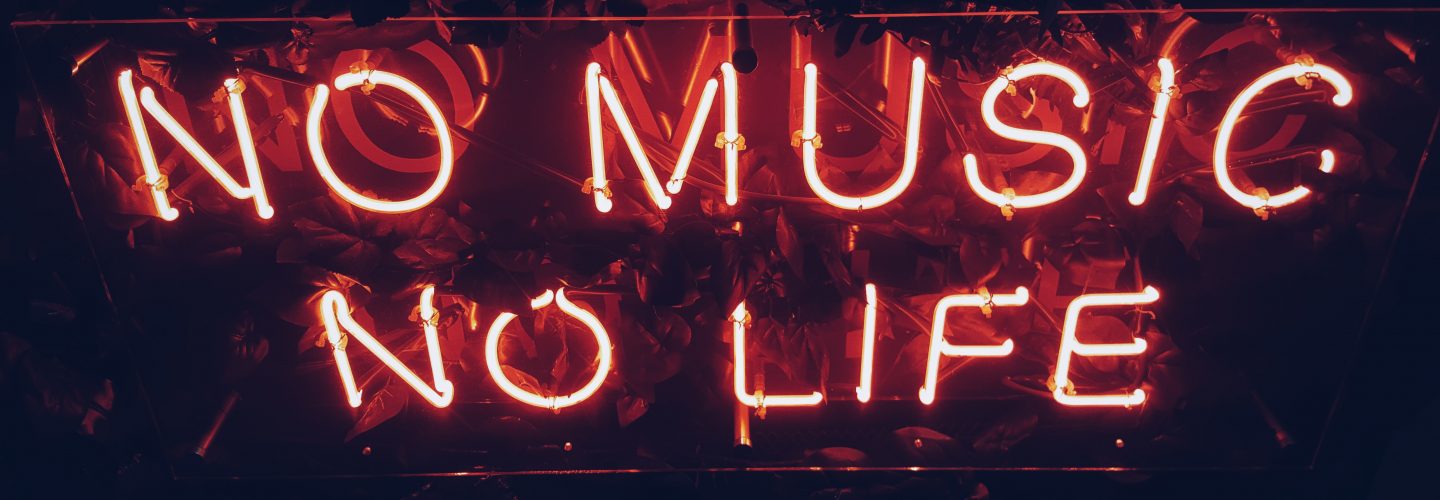Men and women are socialized differently in society and that socialization is relevant and can be crippling in the music as well. “ ‘Girling at the Parlor Piano’ explores how women have been confined to the piano because it’s gendered as feminine. Playing the piano was equated with the simplicity of writing at a typewriter.1Ruth A. Solie, “Girling at the Parlor Piano,” in Music in Other Words: Victorian Conversations (Berkeley, CA: University of California Press, 2004), pp. 85-117. Women were expected to play the piano to court a husband or to entertain their family not for their joy. “Girling” is the social process where women are expected to conform to society’s one dimensional expectations of them satisfying the needs of their families. Beyonce re-appropriated the term “girling” through the lyrics and audiovisual for “Sandcastles” by dismantling the domestic stereotype associated with women playing the piano.
In the Sandcastles music video, Beyonce plays the piano, but it’s a keyboard showing her agency and mobility. The women that have preceded her were coerced into playing the piano. Women being forced to play the piano is symbolic of their lack of mobility and second class citizenship. Having to play the piano probably added to the many sorrows of women. However, Beyonce chooses to play the piano recreating their narrative. She also recreates the narrative because music is her refuge and not the reason she needs a refuge.
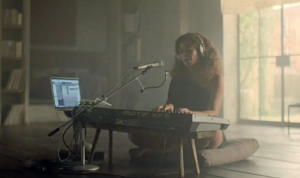
In the first verse, Beyonce sings, “We built sandcastles that washed away. I made you cry when I walked away”. Building sandcastles represents a fairy tale love that is “washed away” but not destroyed. The sand reentering the water is symbolic of their love being reborn in a new form. Water connects back to baptism, and the church has been a pillar in the Black community since the disater of slavery. When enslaved people were emancipated into a ruthless America committed to their war on race, their love for music continued. Their sorrows were sung by Blues singers.
“Blues Singing Women” a chapter out of The New Encyclopedia of Southern Culture: Volume 12: Music highlights how W.E.B DuBois expressed how sorrow songs united black people.2 They, “walked in the darkness sang songs in the olden days — sorrow songs–for they were weary at heart. They came out of the south unknown to me, and yet I knew them as me and mine”. Sorrow songs show the shared oppressions of African American people, but women blues singers sang about love, infidelity, and passion. The blues has a historic precedent of uniting the sorrows of women similarly to Beyonce’s “Sandcastles” . They unit the independent women who are not dating the men that are not on their level or treating them correctly.
The saxophone was used for ragtime music, a style of jazz from 1895 to 1919. Chapter “African American Ambassadors Abroad and at Home” out of Music in America’s Cold War Diplomacy comments on Jazz, “performances and their remarks about political matters, framed by dramatic civil rights controversies, drew enormous attention abroad and significant comment at home.”
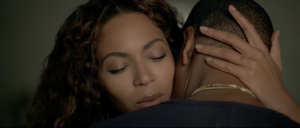
Her lyricism highlights the unique experience of the married Black man and woman. As I previously stated, the first verse says, “I made you cry when I walked away.” Jay Z is notoriously known for his toxic masculinity. One of his most famous songs, “Song Cry” is about his inability to shed actual tears after hurting the woman he loves. Black men are conditioned to be formidable and heartless to navigate a society that disregards them, and Jay Z is no different. Beyonce telling us that he cried reveals he finds solace in his marriage after being beaten down by debilitating racism and poverty.
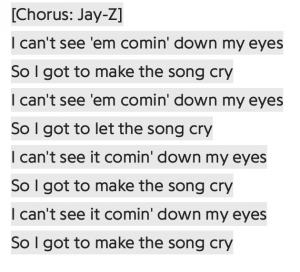
Black men have been tortured, dehumanized, and smited by pure hatred from the world. Africans were stolen from their native land, forced onto ships, separated from their families, smothered by their own feces, and sold like objects. They were beaten until they forgot their native tongue. They were forced to become Black. And then were killed because they were Black. Raped because they were Black. Beaten because they were Black. Sold because they were Black. Stripped of identity, humanity, dignity, and pride because of their race. To stand in adversity, Black men have always had to be brave and prove their “manhood” because they are stripped of humanity in society. As a result of their cumbersome life, they inflict pain on the people they love most, their love. The Black woman already experiences social death because of her intersectionality, but has to carry the burdens of the Black man while running a household.

In the second verse, Beyonce sings, “Dishes smashed on the counter from our last encounter” which is symbolic of her breaking domestic stereotypes. In the process of “girling”, women are taught, they are one dimensional, but Beyonce’s emergence as a songwriter, producer, and performer subverts this notion. Beyonce co-produced “Sandcastles” and only 2.1% of women are producers.
Female producers have struggled to gain agency because of musical engineering being gendered as masculine. However, women like Beyonce have gained notary for their engineer-ship because she is both a performer and a producer. In, “A Studio Of One’s Own: Music Production, Technology And Gender” by Paula Wolfe, a secondary source comments on the historically inadequate treatment of women producers. 2
Wolfe, Paula. “A Studio Of One’s Own: Music Production, Technology And Gender.” Journal on the Art of Record Production ” A Studio of One’s Own: Music Production, Technology and Gender, Journal on the Art of Record Production, Nov. 2012, http://www.arpjournal.com/asarpwp/a-studio-of-one’s-own-music-production-technology-and-gender/.This article creates discourse on how women have to self isolate to build confidence and excel under male domination. In majority of the music video, Beyonce is isolated in an empty house because that is where she can excel creatively.
Women in the music industry are constantly trying to defy the gender disparities, but black women are combating both sexism and racism which is underlined in “Where My Girls At?”: Negotiating Black Womanhood in Music Videos” by Rana Emerson who highlights the celebration of hyper-sexuality and exploitation of black women in the industry but the socially acceptable limited emergence of female producers. 3Emerson, Rana A. “‘Where My Girls At?”: Negotiating Black Womanhood in Music Videos.” Gender and Society, vol. 16, no. 1, 2002, pp. 115–135. JSTOR, www.jstor.org/stable/3081879.As a person with two marginalizing intersections- being black and a woman, Beyonce had to combat notorious stereotypes and she did so in her music and audiovisuals.
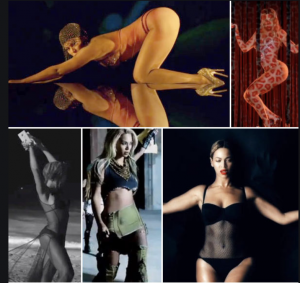
Beyonce is known for embracing her sexuality through her clothing in music videos and performances. She’s also known for her extravagant performances with background dancers. However, in this music video, she is her most natural self and plays her keyboard sitting on the floor in an empty house. Her being in her natural form rejects the oersexualization of women in the music industry. Even when she dresses risque, it’s her choice because she has the agency to do so. She defies gender disparities regardless of how she’s dressed because she chooses her clothing rebuking the socialization of women in society and the music industry.
It is no secret that the music industry pioneered as a boy’s club. Men still predominate as producers, managers, artists, and CEOS of labels. Only 22% of songs on Billboard’s Hot 100 were created by women from 2012 to 2017.4Blistein, Jon. “New Study: Music Industry’s Greatest Gender Disparity Is Behind the Scenes.” Rolling Stone, Rolling Stone , 25 June 2018, https://www.rollingstone.com/music/music-news/new-study-music-industrys-greatest-gender-disparity-is-behind-the-scenes-203036/. An even greater disparity exists between men and women producers. Male musical engineers outnumber female 49 to 1. However the systemic patriarchy has not silenced women but has instead coerced them to work harder. It is a norm, many like Beyonce are refusing to accept which is evident in her helping to produce “Sandcastles” and many of her songs even when she was in Destiny’s Child.
Beyonce is a prolific artist, producer, and lyricist who uplifts her audience through her celebration of black femininity and exploration of gender. She subverts the Girling of woman through choosing to play the piano when the woman who have preceded her were forced to. Like the women blue singers before her and likely influenced her, she’s able sings about love, infidelity, and passion uniting woman. Her music also subliminally speaks to the struggles of Black men and women who are married. Though her husband betrayed her and their marriage, she had to heal the both of them. Black women are constantly forced to be formidable, and Beyonce exemplifies how financial freedom doesn’t leave her unscathed from Black women’s traumatic experiences.

In another song on the album, “Formation”, she exemplifies America’s rigid social and political structure by protesting police brutality and social commentary on Hurricane Katrina. The video is captured in New Orleans, a city very rich with Black Culture, and Beyoncé is surrounded by unified black women. Not only does Beyoncé combat misogyny through her outright appearances and lyricism, but she also does so by emerging as a producer and songwriter, occupations that are gendered masculine. Essentially Beyonce is consistent with her exploration of gender and race through combatting the social death that Black women endure.
References
| ↑1 | Ruth A. Solie, “Girling at the Parlor Piano,” in Music in Other Words: Victorian Conversations (Berkeley, CA: University of California Press, 2004), pp. 85-117. |
|---|---|
| ↑2 |
Wolfe, Paula. “A Studio Of One’s Own: Music Production, Technology And Gender.” Journal on the Art of Record Production ” A Studio of One’s Own: Music Production, Technology and Gender, Journal on the Art of Record Production, Nov. 2012, http://www.arpjournal.com/asarpwp/a-studio-of-one’s-own-music-production-technology-and-gender/. |
| ↑3 | Emerson, Rana A. “‘Where My Girls At?”: Negotiating Black Womanhood in Music Videos.” Gender and Society, vol. 16, no. 1, 2002, pp. 115–135. JSTOR, www.jstor.org/stable/3081879. |
| ↑4 | Blistein, Jon. “New Study: Music Industry’s Greatest Gender Disparity Is Behind the Scenes.” Rolling Stone, Rolling Stone , 25 June 2018, https://www.rollingstone.com/music/music-news/new-study-music-industrys-greatest-gender-disparity-is-behind-the-scenes-203036/. |
